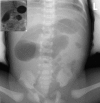Congenital Middle Mesocolic Hernia: A Rare Cause of Neonatal Intestinal Obstruction
- PMID: 27896166
- PMCID: PMC5117281
- DOI: 10.21699/jns.v5i4.371
Congenital Middle Mesocolic Hernia: A Rare Cause of Neonatal Intestinal Obstruction
Abstract
Congenital mesocolic hernia is an extremely rare, but serious cause of intestinal obstruction in children. Given the rarity of this condition, delays in diagnosis and management can have catastrophic consequences. Congenital mesocolic hernias are usually caused by an abnormal rotation of primitive mid-gut and are divided into left and right congenital mesocolic hernias. We report and discuss the clinical and radiological features and management of a neonate with an extremely rare variant, congenital middle mesocolic hernia along with a literature review of this rare condition.
Keywords: Congenital; Middle mesocolic hernia; Neonatal intestinal obstruction.
Figures



Similar articles
-
Congenital sigmoid mesocolic defect as a cause of neonatal intestinal obstruction.BMJ Case Rep. 2019 Aug 28;12(8):e230253. doi: 10.1136/bcr-2019-230253. BMJ Case Rep. 2019. PMID: 31466984 Free PMC article.
-
Small bowel obstruction caused by an unusual variant of paraduodenal hernia. The "middle congenital mesocolic hernia": case report.J Gastrointest Surg. 2014 Aug;18(8):1514-7. doi: 10.1007/s11605-014-2527-z. Epub 2014 Apr 23. J Gastrointest Surg. 2014. PMID: 24756927 Review.
-
Congenital and acquired mesocolic hernias presenting with small bowel obstruction in childhood and adolescence.J Pediatr Surg. 2010 Feb;45(2):438-42. doi: 10.1016/j.jpedsurg.2009.12.006. J Pediatr Surg. 2010. PMID: 20152371
-
Laparoscopic Reduction and Repair of a Mesocolic Hernia Causing Small Bowel Obstruction: A Case Report and Review of Literature.Cureus. 2023 Apr 11;15(4):e37421. doi: 10.7759/cureus.37421. eCollection 2023 Apr. Cureus. 2023. PMID: 37182032 Free PMC article.
-
Internal hernia as a complication of congenital falciform ligament window.Acta Chir Belg. 2013 May-Jun;113(3):233-7. doi: 10.1080/00015458.2013.11680919. Acta Chir Belg. 2013. PMID: 24941724 Review.
Cited by
-
Congenital sigmoid mesocolic defect as a cause of neonatal intestinal obstruction.BMJ Case Rep. 2019 Aug 28;12(8):e230253. doi: 10.1136/bcr-2019-230253. BMJ Case Rep. 2019. PMID: 31466984 Free PMC article.
-
Congenital mesocolic hernia-a case report.J Surg Case Rep. 2024 Apr 26;2024(4):rjae262. doi: 10.1093/jscr/rjae262. eCollection 2024 Apr. J Surg Case Rep. 2024. PMID: 38681484 Free PMC article.
References
-
- Ghahremani GG. Internal abdominal hernias. Surg Clin North Am. 1984; 64:393-406. - PubMed
-
- Newsom BD, Kukora JS. Congenital and acquired internal hernias: unusual causes of small bowel occlusion. Am J Surg. 1986;152:279–85. - PubMed
-
- Tong RS, Sengupta S, Tjandra JJ. Left paraduodenal hernia: case report and review of the literature. ANZ J Surg. 2002; 72:69–71. - PubMed
-
- Martin LC, Merkle EM, Thompson WM. Review of internal hernias: radiographic and clinical findings. AJR Am J Roentgenol. 2006; 186:703-17. - PubMed
-
- Page MP, Ricca RL, Resnick AS, Puder M, Fishman SJ. Newborn and toddler intestinal obstruction owing to congenital mesenteric defects. J Pediatr Surg. 2008; 43:755-8. - PubMed
Publication types
LinkOut - more resources
Full Text Sources
Other Literature Sources
